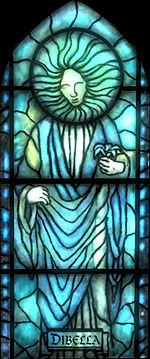- Dibella says: Open your heart to the noble secrets of art and love. Treasure the gifts of friendship. Seek joy and inspiration in the mysteries of love. — Ten Commands: Nine Divines
Dibella, known as the "Queen of Heaven", "Goddess of Beauty", and "Lady of Love", is the popular Aedric "love goddess" of the Eight Divines (and the Nine Divines). In Cyrodiil, she has had many different cults, some devoted to women, some to artists and aesthetics, and others to erotic instruction. Dibella created the Brush of Truepaint in answer to a disabled artist's prayers. She also purportedly created the Helm of the Crusader for Pelinal Whitestrake to help him defeat Umaril the Unfeathered. She is usually depicted as a voluptuous and attractive human female, often either holding large flowers or actually having flowers in place of hands.
Houses of worship dedicated to her are sometimes called Houses of Dibella, though they are also known as chapels or temples. She tends to attract individuals who live and/or espouse an epicurean lifestyle. Followers of Dibella can purportedly commune with the goddess using a person designated by her, known as the Sybil of Dibella, as a medium. Worshipping her is thought of as a more personal, intimate association than worshipping some other Divines. It is said she asks us to "[o]pen your heart to the noble secrets of art and love. Treasure the gifts of friendship. Seek joy and inspiration in the mysteries of love".
Despite her status as a Divine and general popularity, views on the worship of Dibella are somewhat mixed. Worship of her is frequently associated with lewd acts and indecency. Houses of Dibella have been described as "cult[s] of beauty and physical relations". Likewise, the goddess herself has been described as "too lusty", or, more euphemistically, "warm-blooded". In some locales, her worshippers must practice the "Dibellan Arts" in secret for fear of being run out of town.
Gallery
-
DF-Dibella In Person.png
Dibella in person in Daggerfall
-
Daggerfall Signs House of Dibella.png
A symbol for the House of Dibella, as seen in Daggerfall
-
The Great Chapel of Dibella, as seen in Oblivion
-
The Temple of Dibella, as seen in Skyrim
References
|
||||||||||||||
